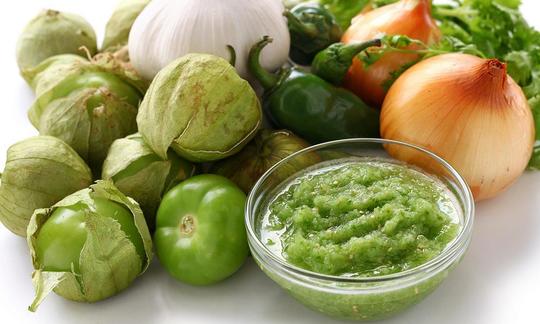Table of contents
The Mexican salsa verde described here can also be prepared raw. The composition of the ( organic) ingredients and the preparation of the salsa varies depending on the region.
Use in the kitchen
The main ingredients of this Mexican salsa verde are green peppers, tomatillos (mountain eggplants), epazote (Mexican goosefoot) and coriander leaves. Due to the ingredients used, the sauce has a predominantly green color.
There are many different ways of preparing it. There are warm, cold, sweet and spicy green sauces. In most recipes, the ingredients are cooked or roasted before being pureed. Heating results in a more olive-green salsa. Raw salsa variants (salsa verde cruda), on the other hand, have an intense light green color.
If you don't have epazote leaves, you can leave them out and add a little lime juice for a refreshing touch. You can also use green tomatoes instead of tomatillos. It is important that they are a green variety (Green Zebra, Green Grape, Evergreen) and that you do not use unripe green tomatoes, as these are poisonous.
Depending on the level of spiciness, use green chilies or jalapeños instead of green peppers. The sweetness of the salsa can be enhanced with a little agave syrup or a pinch of brown sugar. If you want a creamy consistency, you can add the flesh of a small avocado. Alternatively, you can mix in one or two lettuce leaves ( iceberg lettuce orbutterhead lettuce) and lime juice, which gives the salsa a light and fresh consistency.
The Mexican salsa verde is often served cold with Tex-Mex dishes. It is typically served with tortillas or tacos with plantains and red cabbage. It also tastes very good with lentil patties, bean burger patties or grilled eggplant, zucchini and mushrooms. It goes well as a dip with raw vegetables or can be used to season salad sauces and salad dressings. Salsa verde is often mixed into soups, stews and casseroles as a seasoning.
Making your own vegan salsa verde
For our salsa verde recipe you need green pointed peppers, tomatillos, onion, garlic, coriander leaves, epazote (Mexican glandular goosefoot), salt and water. Roast the finely chopped pointed peppers in a pan. Chop all the other ingredients and put them in a large pot and simmer. When the tomatillos are soft, mash everything with a wooden spoon or potato masher and cook the mixture together with the pointed peppers for a few more minutes.
For exact instructions, please read the recipe for salsa verde. It comes from the cookbook " Vegan Mexican Cuisine " by Jason Wyrick.
Homemade raw vegan salsa verde
6-8 servings: For a raw version of salsa verde, puree the ingredients in a food processor. You will need: 1 small onion, 2 bunches of fresh coriander leaves, 500 g tomatillos, 1-2 green chilies or jalapeños, 2 cloves of garlic, 250 ml water and salt. Dice the onion and finely chop the coriander leaves. Finely puree the tomatillos, chilies or jalapeños, garlic and water in a blender. Mix in the onions and coriander leaves. Add salt as needed. Let the salsa sit for at least 30 minutes before serving.
Vegan recipe for corn tortillas with salsa verde
Ingredients (for 6 tortillas): 2 spring onions, 2 green bell peppers, 1 tbsp canola oil, 1 avocado, 2 handfuls of baby spinach, 6 soft corn tortillas, Mexican salsa verde (amount as needed).
Preparation: Wash the spring onions and cut into small rings. Remove the stalk and seeds from the sweet peppers and cut into large cubes after washing. Pour rapeseed oil into a frying pan and briefly sauté the spring onions and sweet peppers. Wash the baby spinach and drain well. Halve the avocado, remove the flesh from the skin and cut into strips. Heat the corn tortillas in the oven according to the instructions on the packaging. Spread the corn tortillas with salsa verde and top with steamed peppers, avocado and baby spinach. Serve immediately.
Vegan recipes with salsa verde can be found under the note: " Recipes that have the most of this ingredient ".
| Not only vegans or vegetarians should read this: Vegans often eat unhealthily. Avoidable nutritional errors. |
Purchasing - Storage
Supermarkets such as Coop, Migros, Denner, Volg, Spar, Aldi, Lidl, Rewe, Edeka, Hofer and Billa occasionally stock Mexican salsa verde in their standard range. Organic supermarkets such as Denn's Biomarkt and Alnatura rarely stock salsa verde. You can find salsa verde in Mexican or Latin American specialty shops or online shops. However, these sauces often contain preservatives, flavor enhancers and a lot of salt, which is why we recommend preparing the salsa fresh.
The availability of salsa verde varies depending on the size of the store, catchment area, etc. You can find our recorded food prices for the DA-CH countries above under the ingredient image - and by clicking you can see their development at different suppliers.
Storage tips
How long does salsa verde dip last? Salsa verde can be stored in the refrigerator for a few days. To preserve salsa verde, you can pasteurize it in a jar.
Ingredients - Nutritional values - Calories
100 g of Salsa verde has an energy content of 29 kcal and is low in fat (0.55 g/100g) and protein (0.90 g/100g). The carbohydrate content is 6.2 g/100g, of which 3.3 g are sugars. 1
Salsa verde is rich in vitamin C (ascorbic acid) : 100 g of sauce contains 55 mg of vitamin C, which corresponds to 69% of the daily requirement. Lemon and orange have similar vitamin C contents (53 mg/100g). Sea buckthorn berries (450 mg/100g) and dried coriander leaves (567 mg/100g) are particularly rich in vitamin C. 1
It also contains large amounts of vitamin K (22 µg/100g) - as is the case in avocados and blackberries. Kale has a particularly high level of this vitamin at 705 µg/100g. 1
Salsa Verde contains a similar amount of vitamin B6 (pyridoxine) at 0.31 mg/100g as durian. Garlic has significantly more of this at 1.2 mg/100g. 1
Salsa Verde also contains small amounts of vitamin A, as RAE, folic acid, potassium and manganese. 1
The complete ingredients of Salsa verde (raw), the coverage of the daily requirement and comparison values with other ingredients can be found in our nutrient tables. In the article Nutrients explained you will get a detailed insight into the topic.
Health Benefits
Freshly made salsa verde is made from nutrient-rich, healthy ingredients. Tomatillos, pointed peppers and fresh coriander leaves are rich in vitamin C. 1 This is a powerful antioxidant, promotes the absorption of iron and inhibits the formation of potentially cancer-promoting nitrosamines in the intestine. 2 Epazote is rich in minerals and trace elements such as manganese, folate (folic acid), potassium, calcium and magnesium. 1
Epazote is effective against intestinal parasites such as roundworms, hookworms and tapeworms. It is also antimicrobial, antibacterial, antifungal and anti-inflammatory. 3,4 Plant extracts from tomatillos (mountain eggplant) show in vitro antibacterial activity against pathogens that are partly responsible for respiratory diseases, among other things. 5
Dangers - Intolerances - Side effects
It is important not to confuse Tomatillos with unripe, green tomatoes. Unripe tomatoes contain solanine, a slightly toxic chemical compound that other nightshade plants also contain. The term Tomatillos is also mistakenly used for unripe tomatoes.
Ecological footprint - animal welfare
In a self-generated calculation, without specific production data, Carboncloud arrived at 1.10 kg CO 2 eq/kg salsa verde. 7 Ketchup has a similarly high CO 2 footprint (1.14 kg CO 2 eq/kg). This means that in terms of the CO 2 footprint, they are better than the average food. 8
A homemade salsa verde is a climate-friendly, resource-saving sauce because it consists of plant-based, raw ingredients. 6.9
The water footprint of raw tomatoes is: 214 lg/kg, for a processed product such as tomato ketchup it rises to about 534 l/kg. 11
For detailed explanations of various sustainability indicators (such as ecological footprint, CO2 footprint, water footprint), see our article: What does the ecological footprint mean?
Animal welfare - species protection
Since farmers in organic farming do not use synthetic pesticides and chemical fertilizers, organic salsa is preferable for the sake of health as well as flora and fauna. 10
Worldwide occurrence
Salsa verde is a sauce that originates from Mexican cuisine. It typically consists of green pointed peppers, green chilies or jalapeños, as well as tomatillos (mountain eggplant), epazote (Mexican goosefoot) and coriander leaves.
There is also a red salsa variant (salsa roja), which is prepared with red tomatoes instead of green tomatillos.
Further information
Salsa verde should not be confused with chimichurri, a herb sauce from Argentina. In Italian cuisine there are also herb sauces, which are known as salsa verde or pesto. In northern Italy, salsa verde is traditionally served with bollito misto, a meat stew. Green sauces are also known in German cuisine. For these, different herbs are mixed with a vinaigrette or a basic sauce based on milk or cream.
Alternative names
Salsa verde is usually also called salsa verde in English, but sometimes also green sauce or green salsa. In French it is called sauce verde and in German green sauce or green salsa.
Bibliography - 9 Sources (Link to the evidence)
| 1. | USDA (United States Department of Agriculture). Nährstofftabellen. |
| 2. | Biesalski HK, Grimm P, Nowitzki-Grimm S, Taschenatlas Ernährung. 6. Auflage. Stuttgart: Thieme Verlagsgruppe; 2015. |
| 3. | Bown D. The Royal Horticultural Society. Encyclopedia of Herbs & their Uses. Dorling Kindersley: London; 1995: 55, 106, 259-260. |
| 4. | Monzote L, Geroldinger G et al. Interaction of Ascaridole, Carvacrol, and Caryophyllene Oxide from Essential Oil of Chenopodium ambrosioides L. with Mitochondria in Leishmania and other Eukaryotes. Phytother Res. 2018;32(9):1729–1740. |
| 5. | Caceres A, Alvarez AV, Ovando AE, Samayoa BE. Plants used in Guatemala for the treatment of respiratory diseases. 1. Screening of 68 plants against gram-positive bacteria. J Ethnopharmacol. 1991;31(2):193-208. |
| 7. | Carboncloud. Schweden. Salsa verde. |
| 8. | Greenpeace Schweiz, Stadt Zürich, Planted Foods AG, Branding Cuisine, Tinkerbelle, Inge, myblueplanet, ProVeg International, Dr. Earth, FightBack und Eaternity. All You Can Eatfor climate - Poster. ayce.earth. 2022. |
| 10. | Zaller J. Unser tägliches Gift: Pestizide - die unterschätzte Gefahr. 1. Auflage. Wien: Deuticke im Paul Zsolnay; 2018:95-171;146. |
| 11. | Mekonnen MM, Hoekstra AY. The green, blue and grey water footprint of crops and derived crop products. Hydrol. Earth Syst. Sci. 2011; 15: 1577-1600. |









Comments